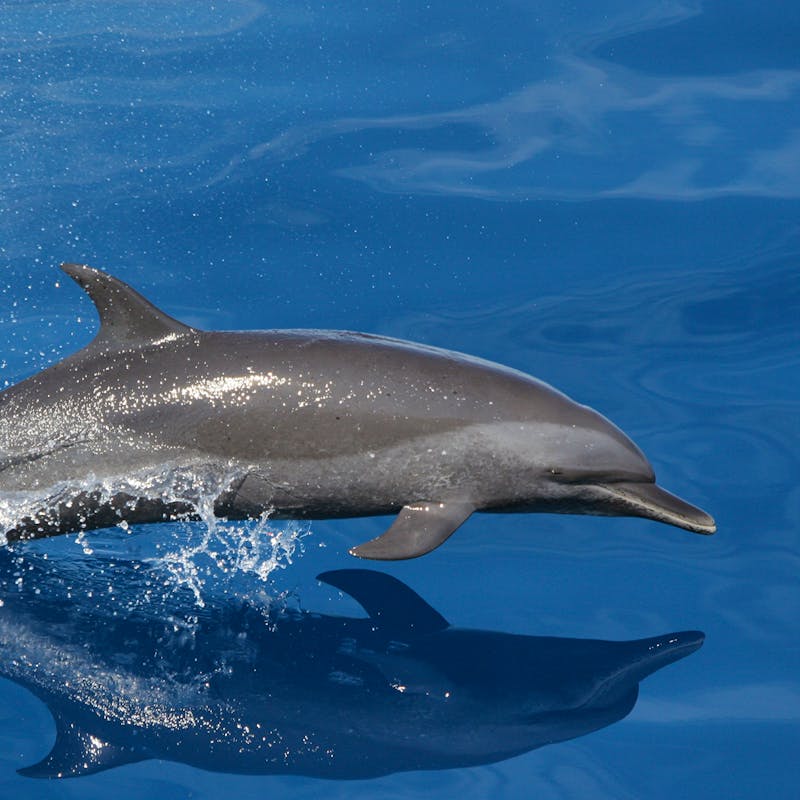Two species of brown algae, Sargassum fluitans and S. natans, form one of the most unique marine ecosystems found anywhere on earth. Entirely pelagic throughout their entire life history, and growing only in the surface waters of the western Atlantic Ocean, Sargassum forms a specialized, floating habitat that is vital to a thriving variety of invertebrates, fish, sea turtles and marine birds. The modest-looking Sargassum that we see today has persisted and reproduced vegetatively in the western North Atlantic ocean for at least decades, and probably for hundreds or even thousands of years.
Earlier I described how and where Sargassum can form into larger clumps or patches wherever the ocean currents are particularly favorable. Aggregations of Sargassum range from small, widely dispersed clumps to rafts and large weedlines that continue for many kilometers. The great changeability in the structure of this habitat is due to constant variations in currents, storms, tides and wind-generated waves.
Sargassum oases in the Gulf of Mexico, the primary nursery ground for the alga off the southeastern U.S, are a focal point for sea life. Many sea creatures not only hide deep in the alga, their color patterns create the perfect camouflage for protection. For example, the slender, translucent pipefish is practically indistinguishable from the algal branches themselves (see above). Likewise, the Sargassum crab mimics the colors and patterns of Sargassum so well that it is practically invisible to all but the most discerning eye.
Crabs, shrimp and tiny fish in turn attract larger marine predators. A good way to visualize how Sargassum serves to enhance the Gulf food web is to imagine an upside-down, floating coral reef. Instead of the base of this reef being on the sea floor, however, it drifts along at the sea surface. Just as with coral reefs, the smaller fish and marine life hide close to the foundation, with the progressively larger predatory fish stacking themselves up at ever greater distances below this habitat.
Many years ago, I had the rather unnerving experience of snorkeling in and under a huge patch of Sargassum that covered several acres over violet-blue water that was thousands of feet deep. Diving underneath, it was startling how dark it became suddenly, the thick algal mats blocking out the intense sunlight, and creating a huge, dark column that penetrated far below the crystal waters of the Gulf Stream. And, lurking right below me, only a few feet further underneath this “reef,” were an assortment of sharks, dolphinfish (mahi-mahi), and the occasional stray barracuda. It was easy to understand why the smaller creatures of this ecosystem stick so close to cover, using every trick they can to hide in safety.
Fish and squid are far more abundant in and around Sargassum than they are in the Gulf’s open waters. At least 80 species of fish alone have been recorded in the alga. Filefish, jacks, blue runners, Atlantic flyingfish and triggerfish are among the most common species. Sargassum habitat seems to provide an ecological advantage as demonstrated by a trend whereby several fish exhibit larger sizes in Sargassum compared to open-water habitat, although it is not evident if this advantage results from better food resources or lack of predation within the algal cover.
This dynamic, floating oasis also supports a diverse variety of marine vertebrates, including sea turtles, pelagic birds and marine mammals. Sargassum is particularly important as a nursery for newly fledged sea turtles, whose small size makes them vulnerable to all sorts of ocean-going predators. Hatchling loggerhead, green, Kemp’s ridley and hawksbill sea turtles have all been recorded in Sargassum off Florida, Georgia, North Carolina and Texas. Several species of seabirds forage in and around Sargassum, and some species frequently roost in or on the thickest mats. Audubon’s shearwater, masked booby, red-necked phalarope and several species of terns are practically specialists in how they target the alga for their feeding bouts. The tropical-dwelling bridled tern, however, is the most closely tied to this habitat. It rarely ever strays in open water far from large clumps of Sargassum, exploiting the alga for feeding, perching and resting.
Quite certainly, a healthy community of Sargassum is essential for a well-functioning marine ecosystem in the Gulf of Mexico. One objective for David Lee on his June cruise through the eastern Gulf aboard the R/V F. G. Walton Smith was to evaluate the condition of Sargassum following
the Deepwater Horizon spill. His findings were well beyond troubling. Although petroleum hydrocarbon residues are often found in trace amounts in Sargassum and its larger associated fauna (after all, both oil and the alga collect into patches from the same currents), what Dave encountered was more like the Black Death. Nothing could live in the noxious stew of oil and alga that he found.
Without a clean, functioning base for the food web, not just the immediate inhabitants of Sargassum, but also the top predators, the large fish, the sea turtles, the marine birds, all were at risk. And this concoction was found just a few weeks into the Deepwater Horizon spill. What will happen to this ecosystem after months of continued exposure to such contamination? This, like many other questions, is what prompts us to go to sea, searching for the answers that can bring the solutions.










Follow Defenders of Wildlife
facebook bluesky twitter instagram youtube tiktok threads linkedin